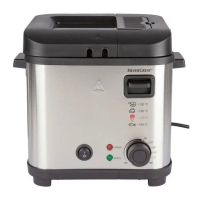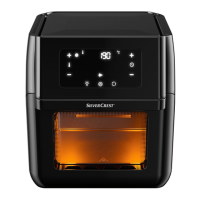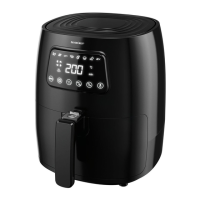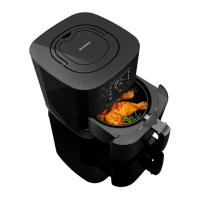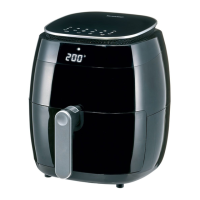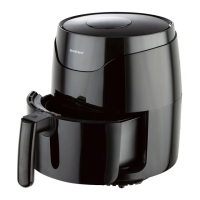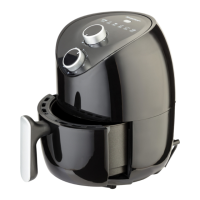29
GB
Which types of oil and fat are
suitable?
There is a wide range of different types of
oil. But not all types of fat and oil are suita-
ble for frying.
• For this deep fryer, we recommend us-
ing liquid frying oil. If you would like to
use solid frying fat, you should first melt
it slowly in a pan at a lower tempera-
ture and then pour it into the deep fryer.
By doing so, you prevent the device
from overheating and the fat from
splashing.
• The fat or oil needs to tolerate high tem-
peratures during frying. Be careful that
the fat/oil may be heated at least up to
200 °C.
• The fats should only have a very low
water content. The water evaporates
when heated, and the fat starts spatter-
ing.
• Oils that are rich in polyunsaturated fat-
ty acids are very healthy when used in
salads, but they are not suitable for fry-
ing, because they do not have the ther-
mal stability required.
• Butter, margarine, and olive oil are not
suitable.
• Rapeseed oil and sunflower oil for ex-
ample are highly suitable.
• Different types of fat or oil should never
be mixed!
Storage of used oil
• Contamination of the oil caused by fry-
ing reduces its useful life. In order to re-
move any coarse dirt, pour the melted
fat through a sieve covered with a pa-
per towel after each frying process be-
fore storing the oil.
• Light and oxygen damage the oil. It
should therefore be stored in a tightly
closed container in a dark, cool, and
dry place.
• Under proper conditions, the fat can be
stored for a few weeks.
Frying table
Getting rid of unwanted flavours
from the oil/fat
Some food, e.g. fish, loses liquid during fry-
ing. This gets into the oil/fat and alters its
smell and flavour. This flavour is then passed
on to the next food that gets fried in this oil/
fat.
With a simple trick, you can reduce or even
completely remove such unwanted flavours.
1. Heat the oil/fat to a temperature of ap-
prox. 150 °C.
2. Put 2 thin slices of bread or a bit of
parsley into the frying basket.
3. Put the frying basket3 into the deep fry-
er and close the lid1.
4. Wait until the oil/fat no longer stops
spitting, and then take out the frying
basket. The oil/fat should now have its
own flavour again.
Food
Temperature
(approx.)
Time
(approx.
minutes)
Vegetables 130 °C 5 - 8
Mushrooms 150 °C 5 - 7
Chicken legs 170 °C 14 - 16
Onion rings 170 °C 3 - 4
French fries
(fresh)
170 °C 11 - 16
French fries
(deep-frozen)
according to the manu-
facturer's specifications
Fish fillet
(deep-frozen)
190 °C 5 - 7
Chicken
nuggets
(deep-frozen)
190 °C 4 - 5
__326314_Fritteuse_B8.book Seite 29 Dienstag, 24. September 2019 8:23 08
